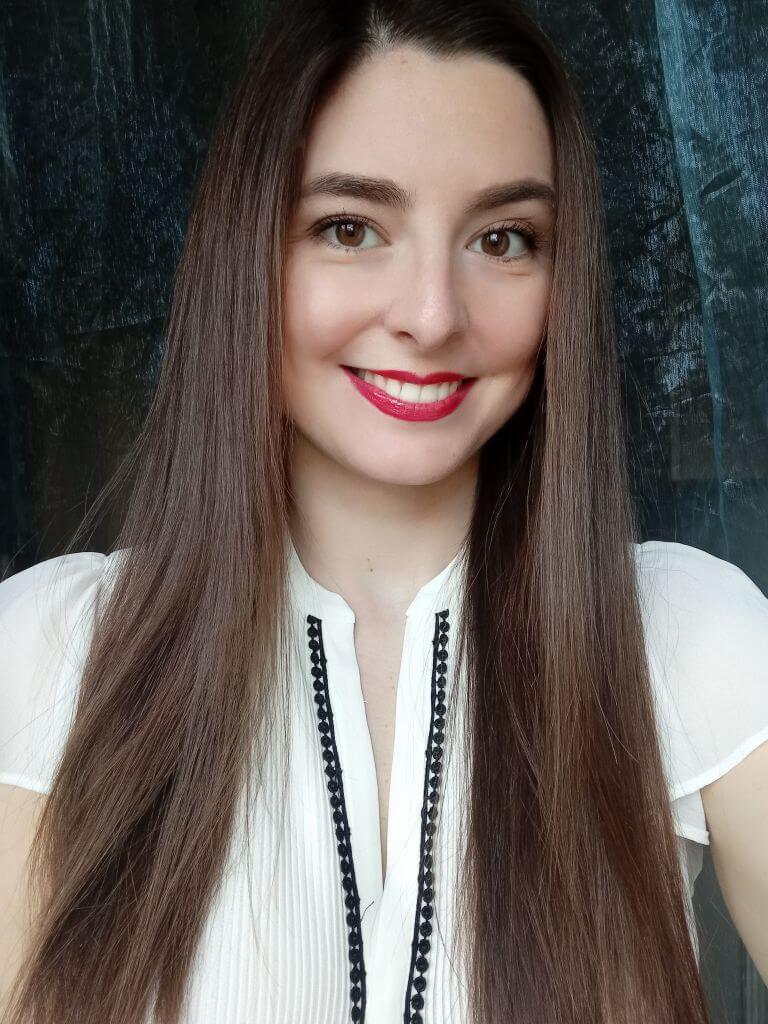Are you struggling to plan staffing or capacity accurately? This could be a hurdle, especially if you’re running a 24/7 business.
To forecast and allocate your resources successfully, use one of the most efficient rotating work schedules — the 2-2-3 work schedule.
This popular rotating schedule saves your employees from burnout, even if they have to work long-hour shifts.
Read on to learn how.

What is the 2-2-3 schedule, and how does it work?
The 2-2-3 shift, also known as the Panama schedule, is a 28-day rotational cycle where each employee performs a daily 12-hour shift.
The Panama schedule often involves 4 teams. For instance, one of these teams works for 2 days, takes 2 days off, and then works for 3 days. That’s why it’s called the 2-2-3 work schedule.
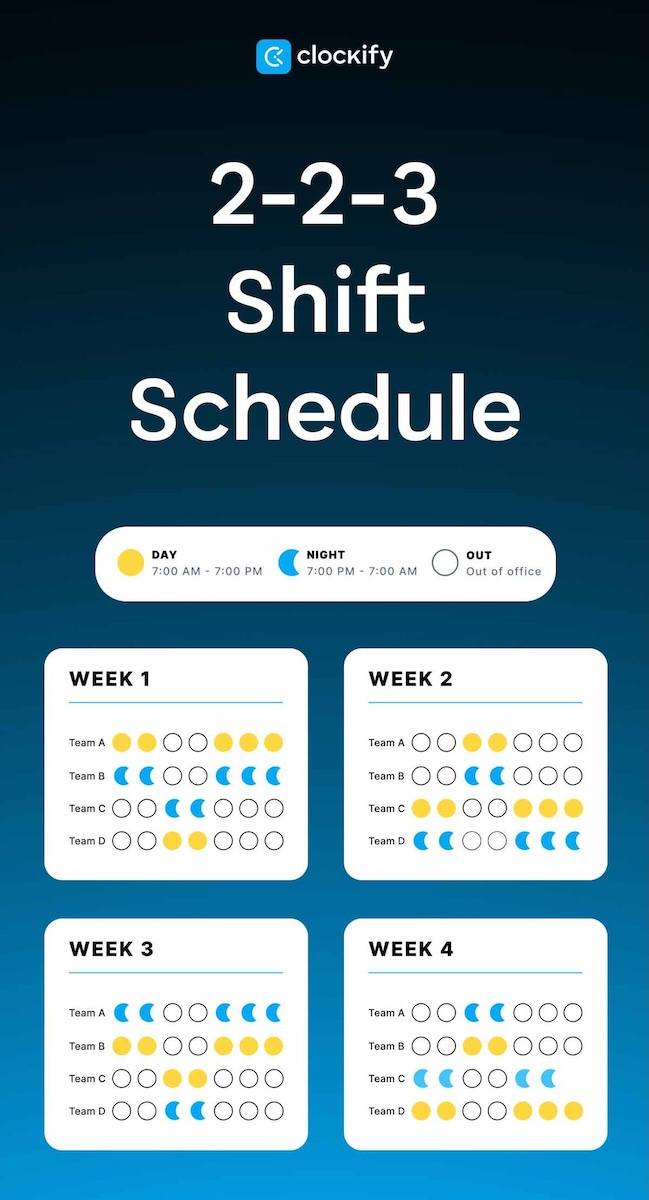
As you can see in the illustration above, the 2-2-3 schedule covers both day and night shifts. So, while Team A works 2 consecutive day shifts (Monday and Tuesday from 7 a.m. to 7 p.m.), Team B covers night shifts (Monday and Tuesday from 7 p.m. to 7 a.m.) during the first week.
Then, teams A and B have 2 days off, while teams C and D take over the shifts.
After that, Teams A and B return to work for 3 days. The schedule goes as follows:
- Team A works day shifts,
- Team B works night shifts, and
- Teams C and D have 3 days off.
Track shift work with Clockify
Who uses the 2-2-3 shift schedule?
Shift work is necessary in industries with varied and extended business hours. It’s especially common in those niches that require employees to be present 24/7 to assist everyone, as is the case in:
- Healthcare,
- Police stations,
- Fire services,
- Manufacturing industries,
- Petrol stations,
- Transportation and airlines,
- Customer service call centers,
- Dispatch services, and
- Media and newspapers.
Since 4 teams are involved in rotating shifts, it’s often challenging to organize the 2-2-3 shift schedule.
Luckily, these industries can rely on project scheduling software like Clockify, which helps teams track their time, thus making them more organized and productive.
Clockify is a part of the CAKE.com Bundle, which provides 3 productivity tools at a heavily discounted price of $12.99. This way, you’ll manage your team projects, your time, and overall communication with ease.
Advantages of the 2-2-3 work schedule
You benefit from plenty of advantages that come with the 2-2-3 shift plan — and we’ll explore some of them below.
Advantage #1: Increased customer satisfaction
Depending on the industry, staying open 24 hours a day may help you build trust and foster a strong relationship with your customers, especially if you have international clients. In such cases, working at night makes sense because some of your clients come from different time zones.
Interestingly, customer agents working night shifts report good customer satisfaction scores — that’s the finding of a study on shift work schedules and call center agents. The reason is simple: call agents usually don’t get interrupted when working graveyard shifts, so they can focus on tasks with ease.
💡 CLOCKIFY PRO TIP
Are you a restaurant owner looking for a tool to enhance your business and meet customer needs? This blog can help you make a decision:
Advantage #2: Lower absenteeism
According to the report on the advantages and disadvantages of 12-hour shifts, 63% of companies implementing such shifts have an absenteeism rate lower than 10%. On the other hand, the absenteeism rate of companies working 8-hour shifts is a whopping 51%.
Since employees working 12-hour shifts have more days off, it’s evident that they have more time to rest and recover from an illness. As a result, they usually request fewer sick days.
💡 CLOCKIFY PRO TIP
What is absenteeism in the workplace, and how do you manage it? Find out in this blog post:
Advantage #3: More leisure time, less burnout
With the 2-2-3 work pattern, employees get to work for only 2 days every other week. Thus, they’re able to spend the rest of their week as they like.
If traveling is their way to relax and spend their free time, working on a 2-2-3 schedule provides them with opportunities for planning weekend getaways. Interestingly, this shift pattern allows employees to work approximately 180 days a year, making their lives more manageable and relaxing.
Also, the flexibility of the 2-2-3 shift schedule can reduce the likelihood of employee burnout. In fact, according to The State of Employee Mental Health in 2024 study, burned-out workers are “nearly 3 times more likely to be actively searching for another job” compared to employees who aren’t experiencing burnout.
If shift workers experience burnout, that doesn’t necessarily mean the 2-2-3 shift is to blame. Certified nursing assistant and fractional CMO Peter Lewis explains that burnout is a leadership failure:

“This isn’t the Panama methodology’s fault; it is the leader not creating the parameters for it to work. Twelve-hour shifts can work, but only if managers prioritize recovery like they do output. Design with empathy or pay the price in turnover and underperformance.”
💡 CLOCKIFY PRO TIP
Would you like to know how many work days you have in a year? This guide will help you calculate for yourself:
Advantage #4: Better work-life balance
The 2-2-3 schedule promotes a healthier work-life balance, making it ideal for employees with children and families.
This work plan lets workers have 2 or 3 consecutive days off — and that’s how they make room for more quality time with their children and families, or even a short trip.
When employees return to work, they’ll be more productive and the quality of their output will be higher, since they’re more energized and well-rested.
Schedule tasks for better balance
Advantage #5: Improved work flexibility
The 2-2-3 shift offers your employees more flexibility with their time. Since this is a rotating shift schedule, the workers aren’t time-bound as 9-to-5 employees.
According to a study on the well-being of emergency nursing staff, nurses included in this research actually enjoyed working 12-hour shifts because they had more time to spend with their families.
Having a flexible schedule allows employees to make arrangements, go shopping, and attend a doctor’s appointment even during workdays, thereby avoiding peak hours and crowds.
However, our interlocutor and president at a high-quality printing company, Brian Kroeker, claims that flexibility depends on how predictable the shifts are:

“Last-minute changes tend to throw people off. We have found that gradually introducing the schedule during an employee’s first month can much better help support them.”
💡 CLOCKIFY PRO TIP
When working flextime, starting and ending hours are flexible. Read on to learn more about this type of schedule:
Disadvantages of the 2-2-3 work schedule
Besides the pros, here are a few drawbacks to this type of schedule.
Disadvantage #1: Health problems
Compared to non-shift workers, employees working shifts are more likely to have irregular meal patterns (like eating at night) — that’s the finding of a study on dietary patterns and rotating shift schedules. In fact, the same research points out that shift workers have a higher risk of cardiometabolic conditions like:
- Diabetes,
- Heart attack,
- Stroke, or
- Obesity.
Similarly, another piece of research has shown a strong link between night shift work and the development of cardiovascular disorders. To make things worse, night shift employees are also more likely to engage in unhealthy activities like smoking or overeating.
Track shift work with Clockify
Disadvantage #2: Increased possibility of errors and injuries
For employees who work rotating shifts, like the 2-2-3 work schedule, staying alert and focused can be difficult — especially when they work night shifts.
According to one captivating study, the risk of making work-related errors is higher at night because employees tend to become tired, and 13% of workplace injuries are attributed to fatigue.
Worryingly enough, the study demonstrates how shift work:
- Disrupts our biorhythm,
- Reduces sleep quality, and
- Contributes to mood disorders.
Ultimately, this leads to poor work performance and a drop in productivity. That’s why 2-2-3 employees must take all necessary precautions and get enough sleep, especially when working 2 or 3 consecutive night shifts.
Disadvantage #3: Fatigue and commuting
Even though following the Panama schedule means having more days off every other week, the other side of the coin is that 12-hour shifts can be exhausting.
For illustration, employees need to be focused and active for 12 hours, and then use public transport or drive home after work. Naturally, it’s difficult to commute home after a long shift because workers are tired.
The situation is even worse when they have night shifts. Employees have to resist the urge to fall asleep behind the wheel. This can be incredibly dangerous for them, so the 2-2-3 work schedule must be carefully implemented and planned out.
💡 CLOCKIFY PRO TIP
If you want to test the advantages and disadvantages of another work schedule, the 9/80 work model, read the following blog post:
Variations of the 2-2-3 work schedule
Apart from the 2-2-3 work pattern, there are other similar work schedules, the famous ones being:
- The Pitman schedule,
- The DuPont schedule, and
- The DDNNOO schedule.
All of these variations are similar to the 2-2-3 work plan, but adapted in different ways.
Variation #1: The Pitman schedule
Unlike the 2-2-3 schedule, the Pitman shift schedule involves employees working in a 2-3-2 pattern.
There are 2 versions of the Pitman schedule:
- Version #1: Fixed Pitman schedule — the first team always works during the day, and the second team works at night.
- Version #2: Rotating Pitman schedule — teams rotate so that one team works the day shift during one cycle, then at night during the next cycle.
Create a schedule with Clockify
Variation #2: The DuPont schedule
Another work pattern is the DuPont schedule, which involves a 4-week cycle and consists of 4 stages (4 consecutive weeks):
- Stage #1: Work 4 night shifts, then take 3 days off.
- Stage #2: Work 3 day shifts, have 1 day off, followed by 3 night shifts.
- Stage #3: Have 3 days off, then work 4 day shifts.
- Stage #4: Have 7 days off.
Variation #3: The DDNNOO schedule
Unlike the 2-2-3 schedule, where 4 teams operate, in the DDNNOO work schedule, 3 teams alternate between:
- Working 2 day shifts (DD),
- Working 2 night shifts (NN), and
- Taking 2 days off (OO).
In this 6-day cycle, each team works two 12-hour day shifts and two 12-hour night shifts. For instance, on the first 2 days, Team A has daily shifts. Then, on days 3 and 4, Team A works during the night. Finally, Team A has the last 2 days off.
How to implement the 2-2-3 work schedule?
Despite being one of the most practical flexible schedules, you may face challenges managing your team while using the 2-2-3 pattern.
To help you avoid the shortcomings of this type of schedule, we’ve put together a few practical tips on how to implement the 2-2-3 schedule successfully.
Tip #1: Define a suitable start time for your employees
The start time of the shifts is very important to your employees, as they’ll be more productive if you choose a time that suits them best.
If your team prefers to start the day early, you can begin the day shifts at 6 or 7 a.m. However, if they choose not to work early shifts, consider starting later in the morning, such as at 9 a.m. In general, you should communicate with your employees and see when they feel most productive, and what would be the most suitable start time for them.
Increase performance with Clockify
Start times sometimes depend on the type of work that your team performs. So it won’t be possible to adjust the schedule for every employee. However, the manager can allow the employees to switch shifts with their colleagues to get the flexibility they need.
Note: When deciding on shift starting times, also consider your clients’ and customers’ needs.
Tip #2: Improve shift time tracking
In the 2-2-3 work schedule, employees work both day and night shifts, regardless of their team. To maintain transparency in work time across both shifts, employees should track their hours daily.
Moreover, as their manager, you should have a clear overview of all the teams and their attendance. An easy way to do that is to have your employees clock in and clock out using the Clockify kiosk. This feature ensures smooth time tracking — simply place a phone or tablet at the company entrance.
When it’s time to start, workers simply need to click Clock in to begin their shift. As shown in the screenshot below, you can add a project called Day shift for everyone working during the day, and do the same for night shifts.

In the same manner, employees just need to click Clock out at the end of their shift.
Furthermore, to view employee attendance, simply navigate to reports in Clockify and click on the Attendance tab.
Here, you’ll see all the workers who have tracked their time during the week, along with their capacity hours, overtime, and time off.
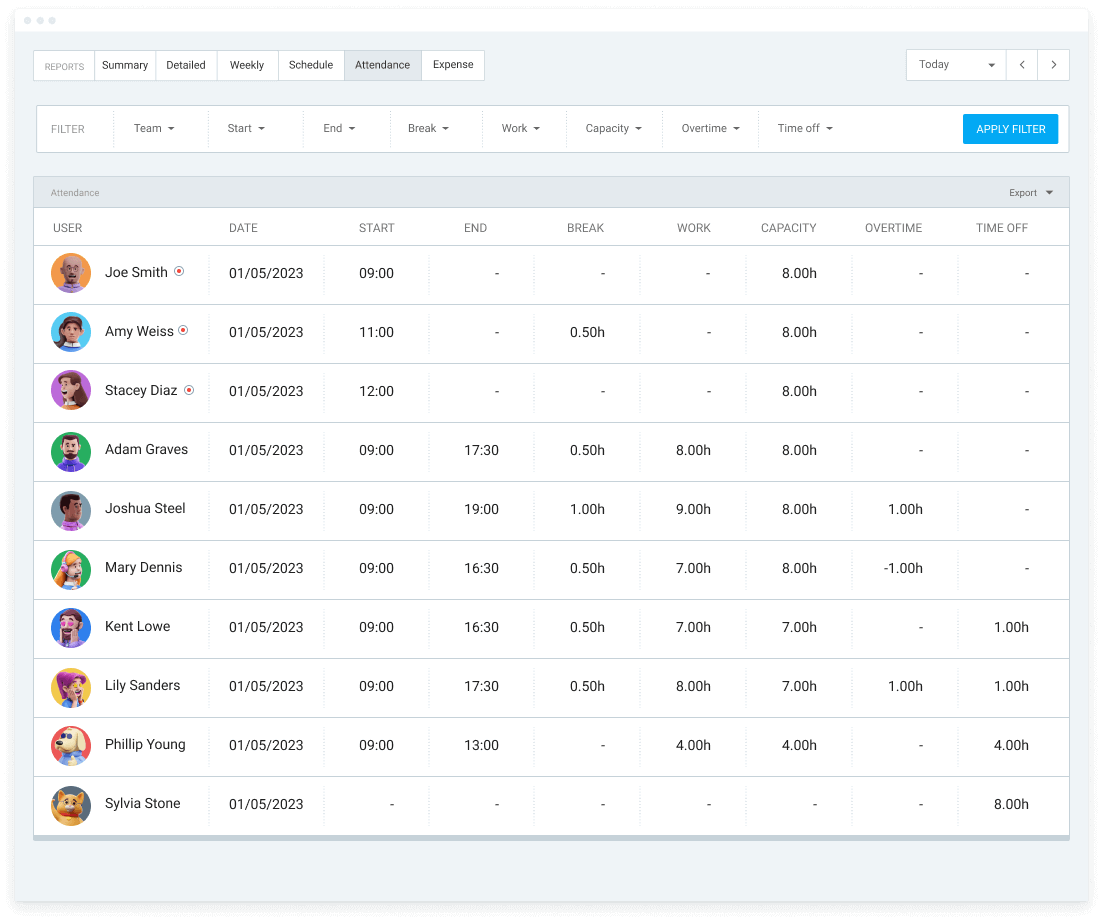
Tip #3: Promote and ensure enough breaks in the shift plan
When working 12-hour shifts, employees need regular breaks to be productive and efficient. After all, it’s not uncommon for stressed employees to have a hard time delivering quality work.
For Kelsey Szamet, an employment lawyer, breaks are essential when working in shifts:
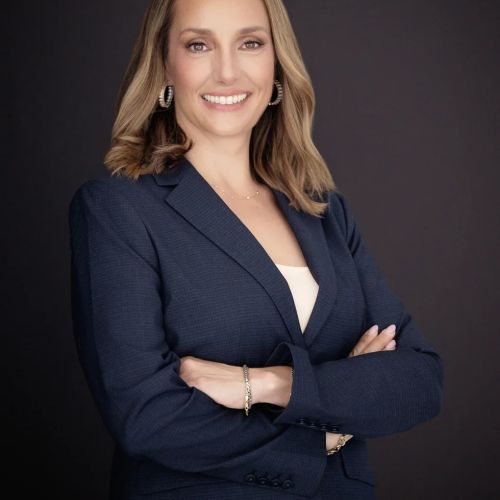
“Without breaks, employees risk mental fatigue, lower morale, and increased risk of errors or accidents. Employers should automatically offer at least two 10-minute relief breaks and a 30-minute lunch break while considering the addition of short rest intervals within the shift. Scheduled, protected breaks increase focus, reduce the risk of injury, and support general productivity.”
To prevent your employees from overworking themselves, encourage them to:
- Take short but frequent breaks,
- Go for a walk, or
- Take a nap.
Not taking enough breaks can lead to increased stress levels, anxiety, and depression. After a break, your employees will feel energized, and your company will benefit from their increased productivity.
For example, you can use the Pomodoro technique to promote taking short breaks and increase efficiency. Simply put, the Pomodoro technique is a time management method that utilizes a timer to break the work process into 25-minute work sessions, followed by 5-minute breaks between them.
Tip #4: Help new workers adapt
Starting a new job can be hard for employees because it requires adjusting to the work environment of the new company. Add the 2-2-3 work schedule to that, and things can get even more difficult — especially for employees who haven’t done shift work before.
To help workers get used to the 2-2-3 work schedule, managers should communicate with them regularly. Leaders should also check whether they can do something to ease this period of transition and adaptation.
For illustration, working shifts can make it difficult for employees to maintain their social lives and hobbies, so it’s up to managers to ensure that employees achieve a good work-life balance.
Interestingly, a study on mental and physical health in new shift workers found that shift working can be harmful to these employees, especially when it comes to their sleep and mental health. Since this impact usually happens in the first 3 to 12 months of work, the same research suggests companies take preventive measures, such as organizing sleep health seminars during the onboarding process.
Apart from these seminars, our expert interlocutor Kelsey Szamet suggests wellness training as a solution to reduce early turnover:

“Employers should proactively support new shift workers by offering wellness training, including guidance on sleep hygiene and nutrition. A phased onboarding process, paired mentorship, and realistic workload expectations can ease the physical and mental adjustment to irregular hours.”
Another way to help new employees adjust to the workload and irregular shift schedules is to provide them with written instructions and assignments they need to complete using schedule templates. During the adjusting period, you can assign a more experienced colleague to help the new hires.
Tip #5: Have adequate lighting
Lighting in the workplace can impact your employees’ productivity in several ways. Too little light can cause sleepiness, while excessive light can lead to eye problems and headaches. But what kind of lighting is right for shift workers, especially during night schedules?
To prove this, a study on light exposure during simulated night work reveals that bright light during night work may improve attention and cognitive flexibility. ScienceDirect defines cognitive flexibility as “the ability to flexibly allocate resources to process and manage information in a constantly changing environment.” Simply put, we need cognitive flexibility when switching between tasks.
So, when organizing workspaces for shift workers, be careful with choosing the type of lighting.
Tip #6: Recommend less caffeine intake and set up a napping area
Working for 12 hours straight can be difficult and tiring, and most workers will rely on drinking a lot of coffee.
Although coffee can be a quick solution to regain focus, consuming too much of it can be harmful to workers. According to a study on the effects of caffeine on sleep, drinking coffee can reduce total sleep time by 45 minutes. That’s why this research suggests having your last cup of coffee at least 8.8 hours before going to bed, to prevent sleep deprivation.
Instead of promoting coffee intake, as a manager, you should encourage napping and set up a “napping area.” In fact, workplace napping is becoming increasingly popular, and many prominent companies, such as Nike, Google, and Ben & Jerry’s, have created designated nap pods and rooms for employees to take naps.
Finally, a 15–20 minute power nap can greatly increase employees’ efficiency and productivity, especially during night shifts.
Tip #7: Provide healthy and balanced meals for your employees
Working in shifts can cause cardiometabolic conditions, like diabetes and stroke. This typically occurs due to disrupted eating and sleeping patterns, an unbalanced diet, and excessive eating.
Since the 2-2-3 employees spend 12 hours a day at work, you should provide healthy and balanced meals, so they can:
- Recuperate their strength,
- Focus better on their tasks, and
- Minimize the negative effects of shift work.
When it comes to the type of food you should offer, a study on strategies for improving firefighter health on-shift recommends protein intake and supplementation as a way to boost overall firefighter health.
💡 CLOCKIFY PRO TIP
If you’re interested in tracking your habits, like eating, sleeping, or working out, check out the best habit trackers on the market:
FAQs about the 2-2-3 work schedule
If you’d like to learn more about this rotating weekend schedule, here are the most common frequently asked questions about the 2-2-3 work schedule.
How does overtime work on a 2/2/3 schedule?
Overtime work during the Panama schedule is a complicated matter.
Namely, the FLSA doesn’t mandate additional pay for weekend or night work. Therefore, it all depends on the agreement between employers and employees.
If you’re an employer, keep in mind one vital FLSA requirement: all covered, nonexempt workers must be paid one and a half (1.5) times their regular pay rate for every hour worked over 40 hours per week.
💡 CLOCKIFY PRO TIP
If you’re wondering if overtime is taxed more, read the following blog post:
What is the ABC shift schedule?
The ABC shift schedule, also known as 24-48 scheduling, is another type of rotational shift schedule. This shift usually involves 3 teams, where each team works for a full day (24 hours).
The cycle lasts for 3 days, during which 3 teams take turns. Each team usually works 1 workday (24 hours) and then has 2 days off.
What is the 3-2 split schedule?
The 3-2 split schedule means that employees work for 3 days and have 2 days off. Similar to the 2-2-3 schedule, employees work longer than 8 hours in the 3-2 schedule.
Create your schedule now
Master your 2-2-3 schedule — with Clockify
If you’d like to have an overview of tracked time and all the projects your team is working on, a powerful tool like Clockify can help.
Namely, the calendar lets you see:
- How many hours of tracked time your team has during day and night shifts,
- What projects your employees have been tackling, and
- Which work patterns exist across different shifts.

Also, if you’re interested in learning more about a specific team member, including their weekly shifts and current tasks, you can view their calendar in Clockify. The screenshot below shows that you just need to click on a team member in the upper right corner and select the time frame you need the data for.

Another way to gain a more detailed overview of your team is to utilize the insights add-on. Apart from tracking hours across the team, this add-on also displays project progress and duration.
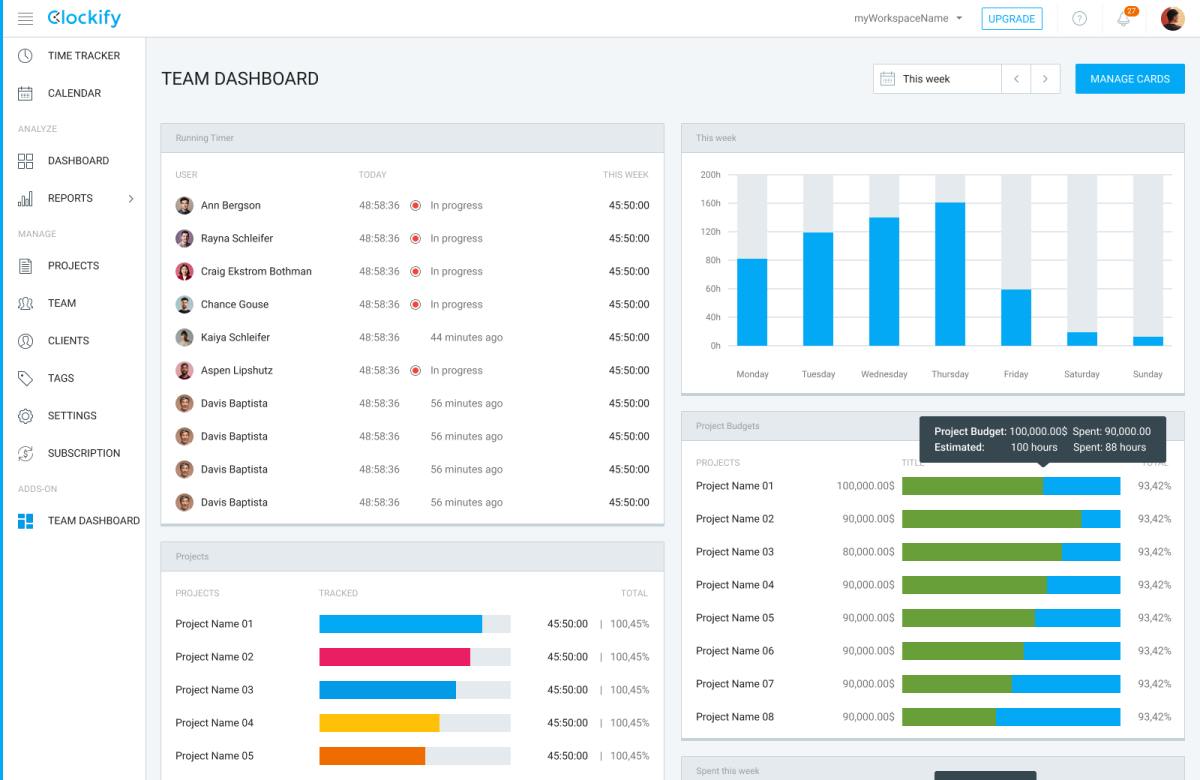
As a result, you’ll improve shift time tracking across the team and ensure that all team members have an equal workload.
In addition to features such as calendar view, kiosk, and project scheduling, Clockify offers its users 24/7 customer support — free of charge.


